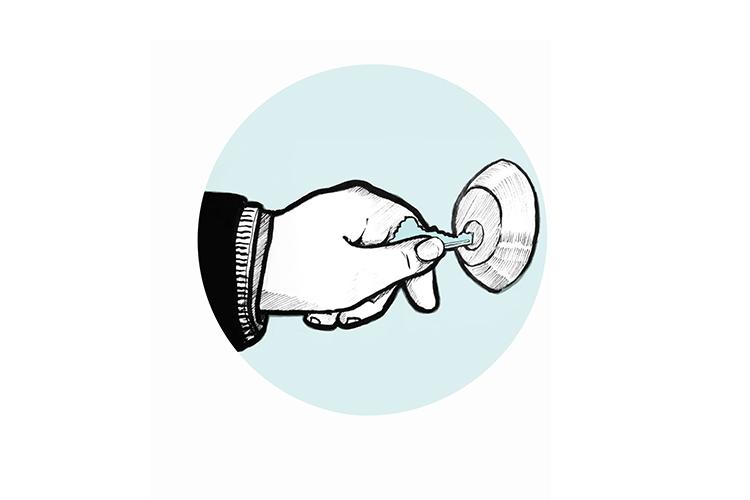“When I Get Home”
Solange Knowles attempts to pay homage to her hometown of Houston, TX.
with her fourth studio album.

The opening track of Solange Knowles’s new album, “When I Get Home,” sets an ambient tone with an electric piano loop and sailing synthesizers backing her repeated vocal: “I saw things I imagined.” The record, accompanied by a promotional film, was meant to be a profession of love to her hometown of Houston, TX.
Knowles excels at creating a mood, which is helped by an all-star production team. The album flows like a stream of consciousness that circulates between ideas and feelings, similar to Devonté Hynes’ album “Negro Swan.” But its lack of consistent references to Knowles’s self-declared theme of Houston starkly contrasts with the confident thesis of Black womanhood in her breakthrough Grammy-winning album, “A Seat at the Table.” Compared to her previous release, the reserved and repetitive quality of Knowles’s delivery in “When I Get Home” is unfulfilling.
On “Down With the Clique” she sings, “We were rollin’ up the street / Chasing the divine” to remind artists from Houston of their youthful dreams and humble beginnings. However, her shy falsetto fights to be heard over a sharp hi-hat and synth beat and does not allow the lyrics to have an impact on the listener.
John Carroll Kirby’s production shines on the album’s third song, “Way to the Show,” which starts with a funky synth bass straight out of 80s boogie. Knowles alludes to the candy-toned paint jobs that play a large role in Houston’s car culture, but once again she spends too much time repeating a seemingly insignificant line: “Uh-huh, uh-huh, you can get it.” The album picks up after this, with a snappy interlude and crisp transition to “Stay Flo.”
This track begins with a tight beat and ad libs from Metro Boomin, evoking a similar feeling to 90s R&B that elevates Knowles’s voice as she finds a lyrically rhythmic groove. However, the words are one-dimensional, and a connection to the theme is absent.
In the following track, “Dreams,” Knowles focuses on adolescent hope. Although its main lyric is “Dreams, they come a long way, not today,” her airy three-part harmonies, and dynamic production from Earl Sweatshirt and Devonté Hynes, carry it effortlessly. The elegance of this track is brought down by a bare interlude entitled, “Nothing Without Intention,” which ironically gives no clue as to what the intention of the album could be.
“Almeda” is an immediate standout for its evident tone of Black pride, but yet again does not reference her hometown. Knowles creates a scene of Black excellence: “Black skin, black braids / Black waves, black days / Black baes, black things / These are black-owned things / Black faith still can’t be washed away.” Syncopated piano from Pharell Williams and cooing from Atlanta rapper Playboi Carti clearly accompany Knowles’s lyrics. “When I come around, they don’t talk down / Diamonds they shine in the dark now,” he repeats – reiterating the success of many Black artists.
The fourteenth track, “Binz” — inspired by reggae music and Knowles’s time spent in Jamaica — features experimental pop artist Panda Bear’s dense bassline and playfully breaks the stereotype of Black people being poor. In the chorus, Knowles finds humor in the phrase “Colored People Time,” traditionally used to demeaningly refer to the negative stereotype that Black people are always running late. “Dollars never show up on CP time / I just wanna wake up on CP time,” she sings.
This flows into the smooth and spaced-out “Beltway,” which clocks in at under two minutes — the perfect amount of time for her repetitions to have the effect of a spiritual chant without being overdone or clumsy. Radiating keys, echoing those of drone music, build to an ascension of synth piano; listeners can imagine Knowles driving in circles around Houston on Beltway 8, the highway loop that surrounds the city.
With this album, Knowles releases a meditative sketch that is especially unsatisfying after her monumental drop in 2016. On “A Seat at the Table,” Knowles uses her lyricism to focus on racial issues; one song, “Don’t Touch My Hair,” directly addresses the objectification that Black women in particular often experience. It is a sharp contrast from the lack of clarity in “When I Get Home.”
Knowles’s most recent release demands engaged listening, and the ideas and feelings of pride that she captures on tracks like “Almeda” only really begin to take root after multiple listens. Her free-form approach to subtle elements of spiritual jazz compliment her use of humor on this album. However, her vocal performance lacks allure and, ironically, the best songs on the record are the ones that do not contribute to the theme she attempts to present.
– Review by Nora Janowski
“Pet Sematary”
The recent reboot brings a chilling and well-executed interpretation of Stephen King’s 1983 novel.
Warning: Spoilers

The recent remake of Stephen King’s “Pet Sematary” gives the original movie a shot at a new life with upgraded effects, acting and a dark new twist to the original storyline.
Though the film features the undead, it is no zombie movie. The mix of tragedy and horror that “Pet Sematary” achieves is more disturbing and personal than many films of its genre.
The film follows Rachel and Louis Creed (Amy Seimetz and Jason Clarke) and their two young children as they learn the dark secrets hidden near their new home in Ludlow, Maine.
The otherwise quiet town is plagued by massive trucks that speed by without warning, often taking the lives of local pets. Eight-year-old Ellie Creed (Jeté Laurence) discovers a cemetery, with a misspelled sign, where local children bury their pets. Past this “pet sematary” and deeper into the woods lies another burial ground, this one with the power to raise the dead.
When Ellie’s cat is killed by a truck in front of the Creeds’ home, Louis, lead by their kindly but secretive neighbor, Jud (John Lithgow), buries the animal in this mysterious clearing. The dead cat reappears at the Creeds’ home the next day, reanimated and seemingly unharmed except for a new violent streak.
At this point, “Pet Sematary” diverges from both the 1983 novel and the 1989 film. When a truck comes barreling down the road, the child caught in its path is not three-year-old Gage (Hugo and Lucas Lavoie), but Ellie.
It is rare that a character’s death in a horror movie is so tragic to watch. Lawrence’s acting skills support the realistic script, making Ellie seem like a real 8-year-old girl. The moment when her young life is cut short under the shadow of the truck is more than shocking; it is devastating. This intense, sorrowful tone is not only more impactful but more appropriate than Gage’s death in the 1989 film.
Ellie’s funeral sheds the tacky feeling of Gage’s in the original film. Where the Stephen King cameo and memorial service fist fight once were, a somber shadow falls over the viewer as they are plunged into the surreal devastation of losing a child.
The grim determination in Louis’ eyes at his daughter’s funeral is at once chilling and tragic. As he did with Gage in the original versions, Louis turns to the clearing deep in the woods to bring back his beloved Ellie, in doing so unleashing a force that will destroy everything that he loves.
It is hard to blame Louis, a grieving father, for wanting to bring his daughter back to life. The desperation that comes with grief is more disturbing than any monster, as the viewer is forced to grapple with the idea that if such a cemetery did exist, they might do the same for their loved ones.
Out of the film’s heartbreaking core grows the unmistakable tendrils of horror. “Pet Sematary” traps viewers in a tense stillness, building up their anticipation to intensify the jolt of each jump scare. Though a sudden cut and a loud noise can be enough to make most viewers jump, gore can tip a startling scene over the edge to a terrifying one.
Where the 1989 film had crusty-looking, unconvincing effects, the 2019 reboot delivers effects so real that they are likely to make the viewer physically cringe. Whether it is a slashed Achilles tendon or a metal stake through the stomach, “Pet Sematary” convincingly replicates the unimaginable.
The film’s set design accentuates the horror movie feel with a dramatic wilderness set that serves as a nod to pretty much every other horror movie that takes place in the woods.
A layer of milky fog covers the forest floor, and the moon casts a bluish glow over the scene. The distinction between the score and the sounds of the woods fades, giving way to a surreal din of creaks, growls and almost-human cries. Human bones line the bottom of a shallow stream, an unexplained detail which melts into the dark, otherworldly backdrop.
Though these details are interesting to look at, the set is so dramatic in contrast with the realistic look of the Creeds’ home that it feels a little out of place.
However, this is not the only aspect of the movie that is integrated unsuccessfully. At the beginning of the film, the score turns ominous as Ellie and Rachel stumble upon a procession of masked children carrying a dead dog toward the “pet sematary.” The children’s masks appear sporadically throughout the movie, on top of gravestones and eventually an undead Ellie takes to wearing one of the masks.
The masks seem to have been thrown into the film only because the image of kids in old-fashioned masks is universally creepy. As the “pet sematary” (“where the dead rest”) is separate from the other burial ground (“where the dead walk”) the children’s procession is an innocent one, and the sinister music is undeserved.
Despite its flaws, “Pet Sematary” is a deeply disturbing movie that is well worth the watch. All of its grief, violence and desperation culminates in a brutal new ending that is even darker than the original. But you will have to see that for yourself.









































